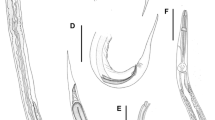Abstract
Domorganus oligochaetophilus n.sp., a new representative of the Cylindrolaiminae Micoletzky (1922) sensu De Coninck (1965) is described. The adults live as endo-parasites in the intestine of littoral oligochaetes (Lumbricillus lineatus O. F. Müller 1774) from the Kieler Bucht (western Baltic Sea). This is the first endo-parasitic record in marine invertebrates of the Nematoda Adenophorea. The new species is characterized morphologically by: 4 cephalic setae, a very small buccalcavity without any sclerotized structures, an esophagus, with 2 bulbs, an excretory pore located posterior to the esophagus, reflexed diorchic ovaria, outstretched diochic testes, and 1 vesicular pre-anal organ in the male. Observations on living specimens show that the parasites live free in the intestinal lumen or are fixed by their spinneret glands at the intestinal wall of their hosts. Their food consists apparently of particulate intestinal contents.
Zusammenfassung
-
1.
Eine neue Art der Nematoda Adenophorea, Domorganus oligochaetophilus n.sp. aus dem Litoral der Kieler Bucht wird beschrieben. Sie lebt als Darmparasit in Oligochaeten [Lumbricillus lineatus] (F. O. Müller) 1774.
-
2.
Es ist die zweite Art der Gattung Domorganus Goodey 1947. Der Generotypus, D. macronephriticus Goodey 1947, stammt aus Oligochaeten eines Wiesenbodens in Winches Farm, St. Albans, England. Es wird vermutet, daß D. oligochaetophilus n.sp. mit seinem Wirt aus terrestrischem oder limnischem in marines Milieu eingewandert ist.
-
3.
Unter den Nematoda Adenophorea ist es der erste Nachweis eines adulten endoparasitischen Nematoden in marinen Wirbellosen. Der Zeitpunkt des Übergangs zur parasitischen Lebensweise scheint jüngeren Datums zu sein, da kaum morphologische Unterschiede zu freilebenden Nematoden vorhanden sind.
-
4.
Der Parasit lebt frei schlängelnd im Darmlumen oder heftet sich mit seinen Schwanzdrüsen an der Darmwand an. Die Nahrung scheint aus Darminhaltsstoffen zu bestehen. Die Produktionsrate ist gering. Die Eier werden nach außen abgegeben und entwickeln sich im freien Substrat. Die Infektion der Wirtstiere konnte nicht beobachtet werden.
Similar content being viewed by others
Zitierte Literatur
Baylis, B. A.: Two new species of Monhystera (Nematoda) inhabiting the gill-chambers of land-crabs. Ann. Mag. nat. Hist. 16, 414–421 (1915).
Bilio, M.: Die aquatische Bodenfauna von Salzwiesen der Nord- und Ostsee. 1. Biotop und ökologische Faunenanalyse: Turbellaria. Int. Revue ges. Hydrobiol. Hydrogr. 49, 509–562 (1964).
Chitwood, B. G.: A revised classification of the nematoda. Papers in helminthology, 30 year Jubileum K. J. Skrjabin. Moscou, 69–80 (1937).
Coninck, L. de: Systématique des nématodes. In Traité de zoologie, T. 4, pp 586–731. Publ. par P.-P. Grasse, Paris: Masson & Cie. 1965.
Deegener, P.: Formen der Vergesellschaftung im Tierreich, 420 pp. Leipzig: Vereinig. wiss. Verl. 1918.
Goodey, T.: Domorganus macronephriticus. n.g., n.sp., a new cylindrolaimid free-living soil nematode. J. Helminth. 21, 175–180 (1947).
—: Soil and freshwater nematodes. A monograph, 390 pp. London: Methuen & Co.; New York: Wiley & Sons 1951.
Hopper, B.E.: Theristus polychaetophilus n.sp. (Nematoda), an external parasite of the spionid polychaete Scolelepis (Scolelepis) squamata (Müller, 1806). Can. J. Zool. 44, 787–791 (1966).
Osche, G.: Über die Vergesellschaftung von Nematoden und Crustaceen, mit einer Beschreibung von Matthesonema tylosa n.g., n.sp. (Nematoda) aus dem Kiemenraum einer Assel. Zool. Anz. 155, 253–262 (1955).
—: Das Präadaptionsphänomen und seine Bedeutung für die Evolution. Zool. Anz. 169, 14–49 (1962).
—: Ursprung, Alter, Form und Verbreitung des Parasitismus bei Nematoden. Mitt. biol. Bund Anst. Ld-u. Forstw. 118, 6–24 (1966).
Steiner, G.: Monhystera cameroni n.sp.—a nematode commensal of various crustaceans of the Magdalen Islands and Bay of Chaleur (Gulf of St. Lawrence). Can. J. Zool. 36, 269–278 (1958).
Thun, W. von: Eine Methode zur Kultivierung der Mikrofauna. Veröff. Inst. Meeresforsch. Bremerh. Sbd. 2, 277–280 (1966).
Author information
Authors and Affiliations
Additional information
Communicated by O. Kinne, Hamburg
Rights and permissions
About this article
Cite this article
von Thun, W. Domorganus oligochaetophilus n. sp., ein endoparasitischer Vertreter der Nematoda Adenophorea im darm von oligochaeten aus dem litoral der Kieler Bucht. Marine Biol. 1, 36–39 (1967). https://doi.org/10.1007/BF00346692
Accepted:
Issue Date:
DOI: https://doi.org/10.1007/BF00346692




